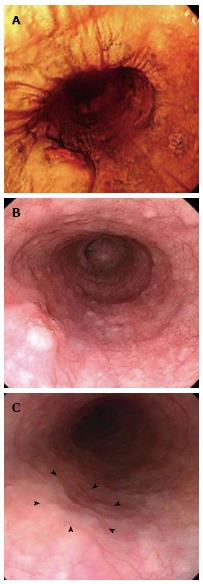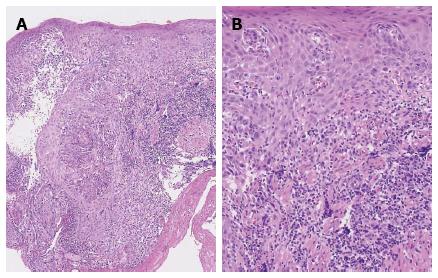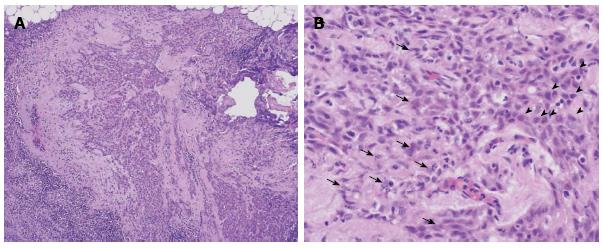Copyright
©2014 Baishideng Publishing Group Inc.
World J Gastrointest Endosc. Aug 16, 2014; 6(8): 385-389
Published online Aug 16, 2014. doi: 10.4253/wjge.v6.i8.385
Published online Aug 16, 2014. doi: 10.4253/wjge.v6.i8.385
Figure 1 The endoscopic findings.
A: The first endoscopy (at the previous clinic) showed a submucosal-like tumor of approximately 10 mm in diameter. The lesion, except for the erosion at the top, was stained with Lugol’s solution; B: The second endoscopy (performed two weeks after the first endoscopy) showed a raised tumor with a central dip. The height of the tumor had decreased; C: The third endoscopy (performed during the endoscopic operation, two months after the first endoscopy) showed that the tumor had become flattened, similar to a scar (arrowhead).
Figure 2 The endoscopically-biopsied material.
A: The inflammatory cell infiltration in the mucosa was remarkable (HE staining, original magnification × 40); B: Squamous cell carcinoma with prominent infiltration of lymphoid cells was revealed (HE staining, original magnification × 100).
Figure 3 The endoscopically-resected material.
A: The gross appearance of the resected esophageal mucosa is shown. There was a superficial smooth tumor measuring 6 mm × 3 mm in the resected mucosa (line), and it was difficult to find the tumor macroscopically; B: The tumor, with prominent lymphoid cell infiltration, was mainly visible in the submucosal layer (HE staining, original magnification × 10). The vertical margin was positive (arrow).
Figure 4 The histopathological findings.
A: Poorly differentiated squamous cells and lymphocytes that had infiltrated into the carcinoma cell nests were observed (HE staining, original magnification × 400); B: Prominent infiltration of cytotoxic T lymphoid cells that stained positive for CD8 was observed between and around the carcinoma cells (× 400); C: Strong expression of human leukocyte antigen-DR was evident in the cell membrane in nearly all carcinoma cells and in the lymphocytes around the tumor (× 400).
Figure 5 The surgically dissected lymph node from the neck area.
A: In the lymph node, which was 5 mm in diameter, a metastasis that was 2 mm in diameter was found (HE staining, original magnification × 40); B: Histological evaluation showed that lymphocytes had infiltrated around the carcinoma cells (HE staining, original magnification × 200). Many denatured carcinoma cells, which had karyorrhexis, an indistinct cell membrane, or karyotheca in the lymph node, were observed (arrow). Many viable carcinoma cells were observed (arrowhead).
- Citation: Uesato M, Kono T, Shiratori T, Akutsu Y, Hoshino I, Murakami K, Horibe D, Maruyama T, Semba Y, Urahama R, Ogura Y, Oide T, Tanizawa T, Matsubara H. Lymphoepithelioma-like esophageal carcinoma with macroscopic reduction. World J Gastrointest Endosc 2014; 6(8): 385-389
- URL: https://www.wjgnet.com/1948-5190/full/v6/i8/385.htm
- DOI: https://dx.doi.org/10.4253/wjge.v6.i8.385

















